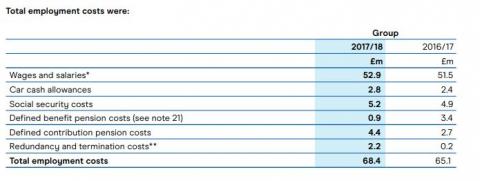Directors' pay just keeps rising
August 2018 - When Canal & River Trust decided to tear down the structure established by Richard Parry and the trustees, just five years after those changes were made, we were told that 78 senior posts would be scrapped and replaced by 60 posts and that just 27 of the new jobs would be senior, earning more than £60,000 a year. Allan Richards has been looking at the impact on the Trust’s £65m a year salary bill.
Back in June, The Floater noted that following the departure of two directors, Sophie Castell and Ian Rogers, C&RT was to undertake a major reorganisation which would see ten waterway regions reduced to six, decentralisation of many functions and senior management changes.
C&RT said that all 78 senior management posts would be scrapped with 60 new posts created. Of these 60 new posts, only 27 would be 'senior' (i.e. salary greater than £60,000). The Floater's article named 15 staff that were being shed as a result of the reorganisation.
The Floater said 'It remains to be see what the effect of these 15 leavers, together with previous leavers and the downgrading of jobs will have on C&RT’s £65m per year salary bill. Inevitably, short term savings will be offset by severance costs and recruitment of Regional Directors.'
Now we have C&RT's annual report to tell us about staff, remuneration and the reorganisation and what little the 2017/18 annual report has to say about it is hidden on page 28 -
'We continued our progress to become a more effective and efficient organisation in 2017/18, committed to working more economically, whether in the energy we use, the processes we operate, or the way we structure our organisation. As part of this commitment, we began the reorganisation of our Executive and Senior Management teams towards the end of the year, to increase our focus on local engagement and delivery, and to streamline and simplify the organisation, concluding our formal consultation in March, with significant reductions in Senior Management numbers.'
Rather surprisingly for a charity trying 'to streamline and simplify the organisation', the average number of persons employed during 2017/18 (1,698) rose slightly from the previous year (1,689). Employment costs rose by five per cent, from £65.1m to to £68.4m driven by a general 2.7% pay increase and £2.2m redundancy and termination costs.
The £2.2m figure seems very high bearing in mind that many of the leavers will go this financial year, not the previous financial year. However, reading the 'small print', it seems that redundancy/termination payments are accounted for when staff are informed that they are no longer required rather than when they actually leave.
Boaters have already picked up on the fact that car cash allowances have jumped from £2.4m to £2.8m. However, this appears to be due to C&RT phasing out its company car scheme in favour of cash allowances. Because company car scheme costs have fallen, the net result is that C&RT has managed to reduce its total employee car costs in 2017/18 by £100,000. That aside, it is still a significant figure for a supposedly 'green' charity and represents over four per cent of its total employment costs.
C&RT provides, in its annual report, a list of staff paid over £60,000 during the year. This list includes, in £10,000 bands, senior staff and directors. The number of staff paid over £60,000 during 2017/18 was 84, an increase of 5 over the previous year. C&RT say that the table banding includes redundancy payments but excludes termination payments made to 21 employees during the year. One is left wondering what the figures would look like if these 'termination payments' were included.
What is very noticeable is that two directors have seen salary increases that now put them in the £210,001-£220,000 band.
Whilst most staff saw a pay increase of just 2.7%, Richard Parry, chief executive, saw his salary increase by eight per cent. His total pay package during 2017/18 increased by over £15,600 - from £194,405 to £210,091.
Total remuneration comprised a salary of £183,105, pension allowance of £15,784, car allowance of £9,768 and benefits in kind of £1,434.
Stuart Mills, chief investment officer, saw his total remuneration during the year increase by £12,000 - from £207,887 to £219,908. This figure included a basic salary of £167,133, a pension allowance of £14,407, car allowance of £9,768, a bonus of £26,385 and benefits in kind of £2,215.
Have other directors seen similar salary increases? The report does not tell us but it is not unreasonable to assume so bearing in mind they have taken on additional responsibilities following the departure of Sophie Castell and Ian Rogers.
Last year, the 'fat cats' got a little fatter whilst those beneath them were made redundant or had to accept jobs on a lower pay scale due to the reorganisation.
C&RT's reorganisation will limp along into 2019. All the current evidence says it will have little effect on visitor numbers or the Trust’s ability to generate charitable income (both needed to convince government to continue to provide funds).
Sadly, it seems it will have a negative effect on C&RT's willingness to maintain its waterways. Anybody who thinks this is not the case needs to have a close look at this 'slide' taken from the March Council meeting -
'Functional Maintainer' to 'Community Therapist'! C&RT, it appears, are no longer interested in its primary responsibility of maintaining its waterways for navigation ...
As one boater, famous for mixed metaphors, exclaimed 'They continue to rearrange deckchairs and are now throwing some over the side. All this whilst Rome burns'.
(At the time of writing this article (21/08/2018), C&RT have eighteen Emergency Navigation Closures in place)
Photos: (1st) CRT employment costs, (2nd) CRT salary numbers, (3rd) Stuart Mills, Chief Investment Officer now £12,000 a year better off, (4th) Richard Parry - now more than £15,000 a year better off, (5th) Now a Waterway and Wellbeing charity.










